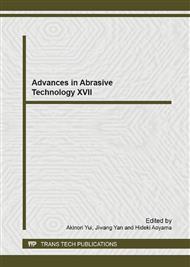p.423
p.429
p.435
p.441
p.447
p.452
p.458
p.467
p.473
Study on the Tribological Property of Bionic Lead Rail Using ABAQUS
Abstract:
Archard wear theory, which describled the relationship between wear volume and material hardness, coasting distance and loading, was the classical theory of tribology problem. According to Archard wear theory, bionic lead rail was compared with ordinary lead rail based on ABAQUS software in the same conditions. Friction and wear property of bionic lead rail were studied, including the maximum contact surface, the distribution of working point of friction force and transformation law of friction force. The results indicated that the maximum contact surface of bionic friction pair decreased obviously and the variation of contact surface was steady. The distribution of working point of friction force for ordinary lead rail was relatively concentration. The distribution of working point of friction force for bionic lead rail was relatively dispersion. Friction force for bionic friction pair decresed to some extent, but the peak friction force was relatively larger.
Info:
Periodical:
Pages:
447-451
Citation:
Online since:
September 2014
Authors:
Price:
Сopyright:
© 2014 Trans Tech Publications Ltd. All Rights Reserved
Share:
Citation:


